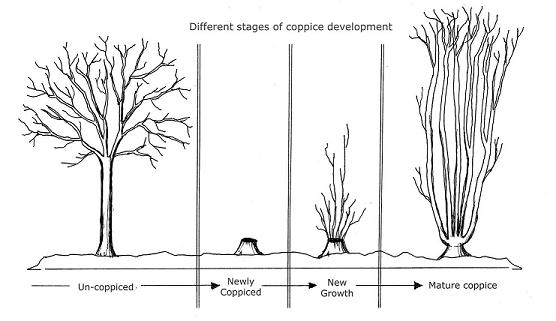Coppicing for woodland biodiversity
- Natural England

- Apr 29, 2020
- 2 min read
Earlier this year our team of staff and volunteers began working in a densely wooded area at Derwent Gorge NNR, with the aim of thinning out the canopy by coppicing some of the old hazel stands. This was an area of the wood seemingly untouched for many decades, resulting in some beautiful old trees, but lacking an understory structure of shrubs or ground vegetation. This is a common sight in an old woodland where almost all trees are of the same age. They form a dense canopy which sunlight struggles to penetrate, causing a dark and stunted understory with very little natural regeneration of trees.
An area of the dense hazel woodland at Derwent Gorge in winter, and a diagram of diverse woodland structure (University Of Missouri Sc1 St Environment).
This is where coppicing, a traditional method of woodland management which has been practiced throughout history, can be used to regain structural diversity. The practice involves cutting the tree stump close to the ground and leaving it at an angle in order to allow rainwater to drain off it. This will produce new shoots in spring, and if left, continue to grow into large stands. This method does not work for all species of tree but for some such as hazel, lime, ash and oak it is very successful.
A diagram of the stages of coppice development (http://dorsettreeworx.co.uk/services.php), and a relatively mature hazel coppice.
By leaving these trees to grow back, we create a diversity of age in the canopy, as well as allowing more sunlight through to the ground layer. This will encourage ground vegetation such as brambles, bluebell and primrose to grow, as well as larger shrubs. These new microhabitats increase the general biodiversity of a woodland by creating food sources and shelter for a number of species. Maintaining structural diversity of a woodland in this way is very effective.
At Derwent Gorge we decided to use the same method to create a small clearing called a 'glade'. This involved coppicing a number of the hazel trees in a single area to make an open space within the woodland where light can encourage new growth. Using the material from the coppiced hazel we created deadwood piles which act as microhabitats for many invertebrates, fungi and lichen as the wood decomposes.
We are hoping to see a flourish of new growth once we are able to visit the reserve again in summer. Although we were not able to see the woodland this spring we expect there to have been many primroses, honeysuckle, bluebells and even butterflies thriving in the extra sunlight. A big thank you to our fantastic volunteers who made this project possible with their hard work and enthusiasm. We would not be able to continue to manage our reserves in the way that we do without your help.
If you would like to read more about woodland management and coppicing here are some good websites: https://www.conservationhandbooks.com/coppicing-cut-trees-conservation/ https://www.wildlifetrusts.org/wildlife-advice/how-manage-woodland-wildlife

I am looking forward to more sunny days out on the reserves!
Reserve Warden
Charlotte Pink






















Comments